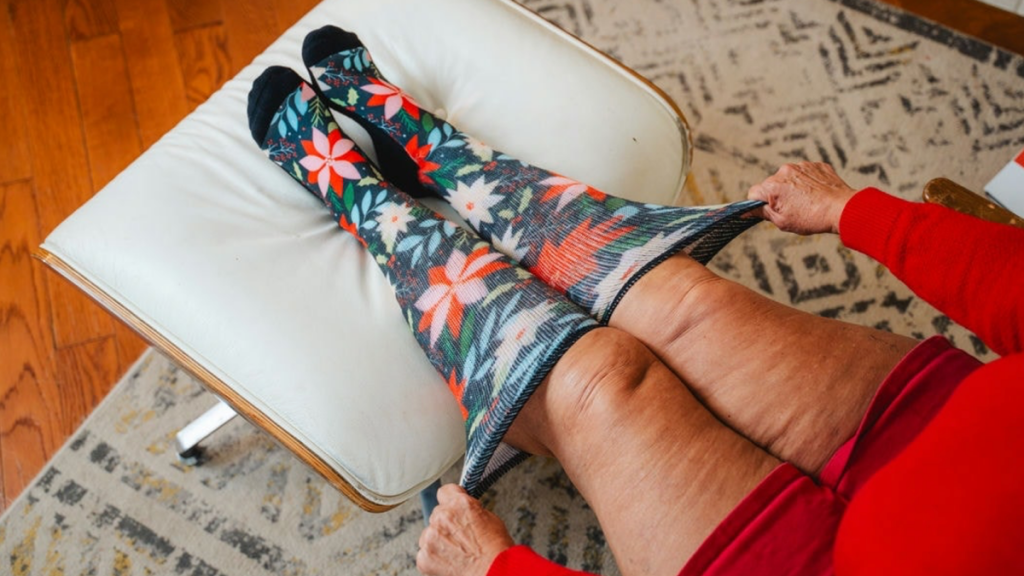Diabetes, a chronic disease affecting millions worldwide, has a profound impact on various parts of the body, and feet are no exception. People with diabetes face a unique set of challenges when it comes to foot care, making the choice of appropriate footwear and accessories crucial. Among the options available, non-binding diabetic socks have emerged as a vital tool in managing and preventing foot-related complications. This comprehensive guide will explore how these specialized socks can significantly benefit diabetic feet.
1. Alleviating Pressure and Improving Circulation
One of the best features of non-binding diabetic socks is their ability to reduce pressure on the foot and leg. Traditional socks often have tight elastic bands at the top, which can constrict blood flow. This is particularly detrimental for individuals with diabetes, as they commonly experience poor circulation, especially in the extremities. Non-binding diabetic socks are designed with loose-fitting tops, promoting blood flow and reducing the risk of circulatory issues. Enhanced circulation aids in wound healing and prevents the accumulation of fluids, leading to healthier feet.
2. Moisture Management
Moisture control is a critical aspect of diabetic foot care. Excess moisture can create a breeding ground for fungal and bacterial infections, particularly problematic for those with diabetes due to compromised immune systems. Non-binding diabetic socks are typically made from materials that wick moisture away from the skin, helping to keep the feet dry and reducing the risk of infections.
3. Minimizing the Risk of Foot Injuries
Diabetes can lead to neuropathy, a condition characterized by nerve damage and reduced sensation in the feet. This loss of sensation means minor injuries, pressure points, or blisters can go unnoticed, potentially leading to severe complications. Non-binding diabetic socks address this issue through various design features. They often come with padded soles, providing additional cushioning and reducing pressure points. They are designed with minimal seams or inverted seams to prevent rubbing and blistering, thereby minimizing the risk of foot injuries.
4. Antimicrobial Properties for Infection Control
Good non-binding diabetic socks come with built-in antimicrobial properties, helping to control bacterial and fungal growth. This is an essential feature for people with diabetes, as even a minor infection can escalate quickly and lead to serious complications.
5. Comfort and Compliance
Comfort is a crucial factor in foot care for individuals with diabetes. The more comfortable the socks, the more likely individuals are to wear them consistently, ensuring they reap the benefits. Non-binding diabetic socks are designed with comfort in mind, encouraging adherence to foot care routines and contributing to overall foot health.
5. Support and Stability
Despite their non-binding nature, these socks still support the feet. They are designed to fit well without being constrictive, ensuring that the feet are supported without compromising blood flow. This balance between support and non-constriction is a crucial aspect of their design, tailored specifically for diabetes patients.
6. Adaptability to Foot Shape
Diabetics often experience changes in the shape of their feet due to various complications associated with the disease. Non-binding diabetic socks are made from stretchable materials that adapt to the shape of the foot, providing a comfortable fit regardless of any changes in foot shape.
7. Reducing the Risk of Fungal and Bacterial Growth
The moisture-wicking properties of non-binding diabetic socks play a crucial role in reducing the risk of fungal and bacterial growth. By keeping the feet dry, these socks help prevent conditions such as athlete’s foot, which can be particularly problematic for those with diabetes.
8. Long-term Benefits and Preventive Care
While non-binding diabetic socks are not a cure for the foot-related complications associated with diabetes, they play a significant role in preventive care. By addressing various issues such as poor circulation, pressure points, and moisture management, these socks contribute to long-term foot health and can prevent the onset of severe complications.
Conclusion
Non-binding diabetic socks present a wealth of benefits for individuals managing diabetes, addressing the unique and specific foot-related challenges of the condition. They play a crucial role in enhancing circulation, preventing foot injuries, providing unparalleled comfort, and aiding in the daily foot inspection routine, all contributing to overall foot health. Brands like Viasox have recognized these needs and offer a range of non-binding diabetic socks, ensuring that individuals can access high-quality options tailored to their requirements. By incorporating these specialized non-binding socks into their foot care regimen, those with diabetes can take significant proactive steps toward maintaining optimal foot conditions, preventing serious complications, and promoting long-term well-being.
Laila Azzahra is a professional writer and blogger that loves to write about technology, business, entertainment, science, and health.
